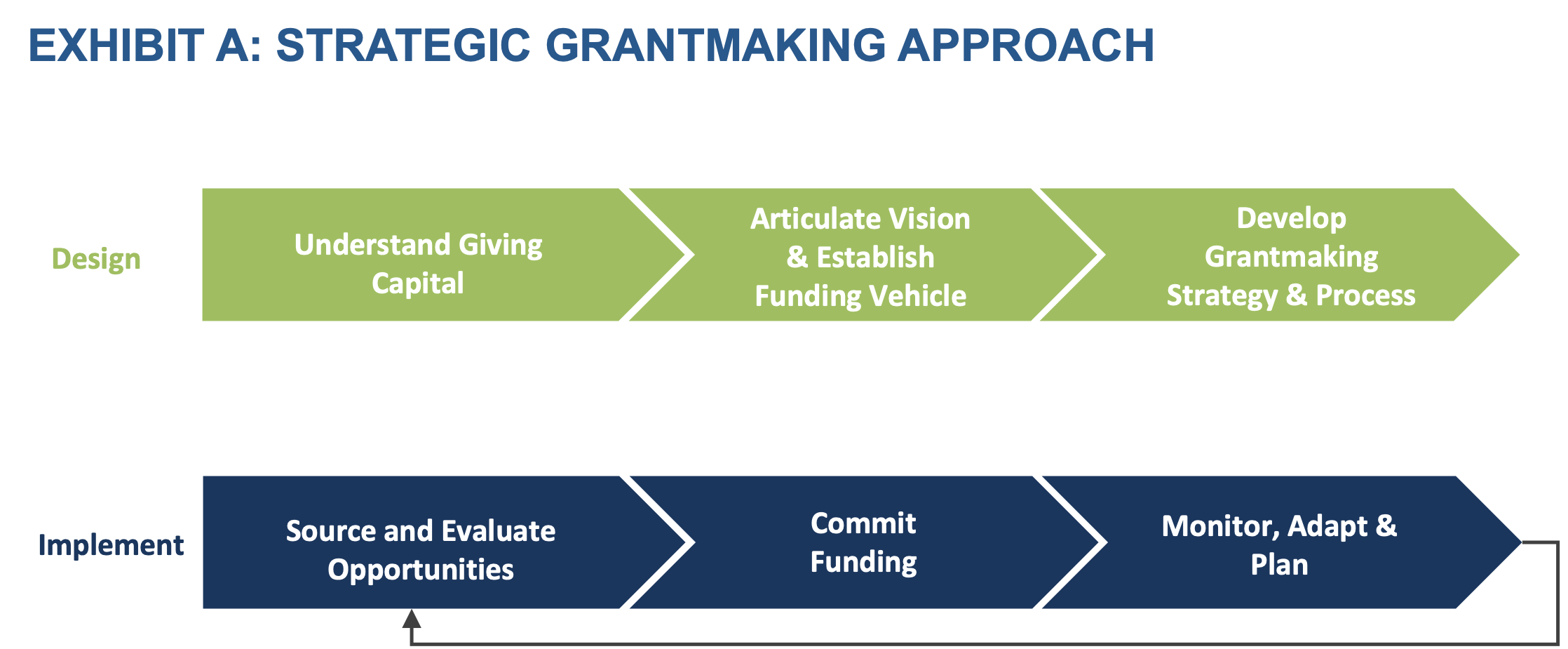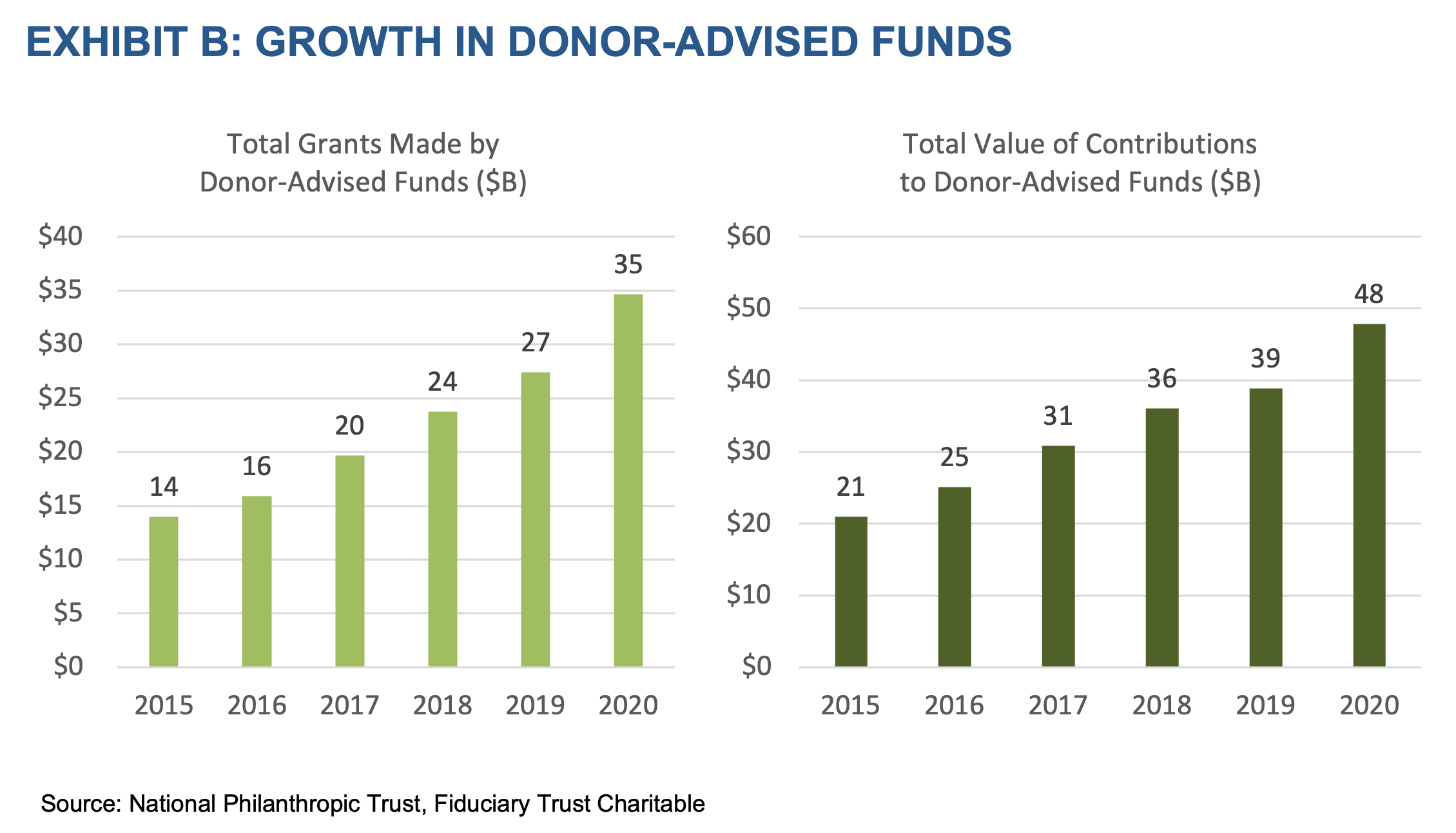Discussion between Todd Eckler, Executive Director of Fiduciary Trust Charitable, and Betsy Brill, President of Strategic Philanthropy, Ltd.
This webcast is focused on helping individuals, foundations and corporate grantmakers increase the impact of their charitable giving through enhancing their charitable strategies and grantmaking processes. In this webcast, we discuss:
- The benefits of establishing a giving strategy
- Advice on each step in the giving strategy process
- Guidance on developing an ongoing grantmaking process
- Resources (downloads and organizations) to help with your grantmaking activities
The discussion is moderated by Todd Eckler, Executive Director of Fiduciary Trust Charitable, the sponsor of flexible, advisor-managed donor-advised funds. Under his leadership, FT Charitable earned a 2020 Stevie Award for innovation in its donor-advised fund program and achieved record growth in 2021.
He is joined by Betsy Brill, President of Strategic Philanthropy, Ltd., a leading philanthropic consulting firm she co-founded over 20 years ago. During that time, the firm has facilitated over $10 billion in gifts, and Betsy and her team have advised hundreds of individuals, families and closely-held businesses on their charitable giving strategies.
Below is an edited transcript of the webcast.
The Benefits of Charitable Giving
Todd: Before we get into the approach for developing a charitable giving strategy, what are some of the benefits of developing a strategy?
Betsy: Taking the time to plan and really having clarity of purpose, both for your near-and long-term vision, helps you stay on track and ensures that there’s continuity over time. I’d also say that knowing who you are as a donor and how to engage in good practice and how to move the needle on specific issues ensures that you are creating successful partnerships with the organizations you are supporting.

1. Understand Giving Capital
Eckler: Let’s dive into the first step — understanding giving capital. This is an important place to start as it will define how much funding is available and when. You want to take into account your expected income and other sources of assets in future years, current level of assets and expected growth, as well as expenses and goals for transferring wealth to the next generation. There are also a number of tax considerations in terms of when and how to fund charitable causes. Ultimately, you need to develop an initial plan for how much funding you’d like to commit to in your lifetime, as well as bequests.
Brill: I’d like to add to that, Todd. It is critically important to know what financial resources are available so that the charitable giving strategy you develop is realistic, realizable and can have the kind of impact you want. It isn’t just your lifetime giving, but the legacy giving you may want to do that has to be taken into consideration from a financial planning perspective.
2. Articulate Vision & Establish Funding Vehicle
Eckler: Once you have a good understanding of the capital available, the next stage is articulating your vision.
Brill: Absolutely. This is where it’s important to take time to articulate your motivations and goals and your values. First, look at what is driving you to be philanthropic. Do you want to share your good fortune with society? Do you feel compelled to move the needle, maybe on climate change or on food insecurity? Is there a particular medical issue, potentially, that’s impacting your family? Do you have particular religious beliefs that drive your philanthropy? What legacy do you hope to leave for subsequent generations? We always ask donors to complete a sentence: “I’ll consider my philanthropy to be successful if ___ fill in the blank.” I also think it’s so important to articulate your values. Values are the things that are sustained and really don’t change. What have been the guiding lights of your life? Take some time to articulate those values.
Eckler: Ideally, you would articulate your vision, and then that would help you decide which type of charitable giving vehicle is the right one. In reality, a lot of people fund their giving capital up front through a foundation or donor-advised fund or something else, but don’t have all of the vision fleshed out. And as it relates to charitable giving vehicles, there are a number of different vehicles that one can consider. Some of the most popular ones are clearly private foundations, donor-advised funds, charitable remainder trusts, and charitable gift annuities. Donor-advised funds, as you know, have grown dramatically given their flexibility, low cost, and ability to serve the needs of a broad range of donors. In fact, from 2015 to 2020, contributions to donor-advised funds grew by over 90%. And during the same time period, grants from donor-advised funds more than doubled, reaching $35 billion.

3. Develop Grantmaking Strategy & Process
Eckler: Why don’t we move to the next step in the charitable giving strategy process, which is defining the grantmaking strategy and process?
Brill: Once you understand the issue areas and where you can best invest your charitable dollars, the next step is to put the pieces together to manage your charitable giving. And this includes developing giving guidelines that will summarize your priority areas and the strategies that you want to support, as well as your geographic focus and the population you want to focus on, and the types and size and range of grants that you’re going to be providing. One of the ways in which we help clients is by creating a landscape analysis. In a landscape analysis, we explore the context of the issue that you’re hoping to support, and then any recommendations from the field about how best to tackle the issues. The analysis also provides a number of organizations that align with the focus areas that you’ve identified.
Finally, you need to determine how you’re going to actually make your giving decisions. For private foundations and trusts, you have a board. But for donor-advised funds, we recommend setting up a giving committee. Giving guidelines should be made available to the board and the giving committee to help guide decision-making. That’s where your focus areas are, your strategies, the types of grants you’re going to make. And then think about how you’re going to assess those funding opportunities that are before you.
Eckler: At Fiduciary Trust Charitable, we definitely see what you mentioned, with donor-advised funds establishing giving committees where multiple family members will come together. Our advisors will typically meet with the giving committee on a regular basis, connecting them to resources to help with their grant making, receiving grant requests in the manner most convenient for the committee, and discussing the donor-advised fund’s investment strategy.
4. Identify & Evaluate Opportunities
Eckler: Well, we’ve spent a lot of time talking about the design of the charitable giving process. I want to change gears now and talk about implementing the grant process. The first implementation step is identifying and evaluating potential grant opportunities. What are some of the key factors to consider at this stage, Betsy?
Brill: As we discussed, Todd, the landscape analysis is really a way to understand the field and to source some opportunities that align with your interests. But that’s not the end of the sentence. After that, you have to drill down further. If there’s an organization or organizations that you’re particularly interested in, you need to find out more. You can meet with and talk with the organization’s leadership, development and program staff, and even board members.
You want to look at their budget, their financial statements, and their 990s. Are there any red flags? And understand their sources of support. Who else is supporting this organization? Understand their board and their senior professionals. On paper, all of this due diligence only takes you so far. It’s also about building a relationship of trust and open dialogue and cultivating a partnership. Once you have a list of organizations that meet your funding criteria, you can go ahead and solicit proposals.
5. Commit Funding
Eckler: The next stage in the process is committing funding. What are some of the issues to consider in that process?
Brill: Donors are only as effective as the nonprofits they support. It’s a marriage. What that means is you need to really listen to the field and allow nonprofits to articulate the kind of funding they need. When you’re thinking about how to situate your grant and the type of contribution to make, think about multi-year funding. It truly helps nonprofits plan if they know that this funding is going to be coming into their budget over the course of the next two or three years. It allows them to plan for their organization, their program, or project.
Eckler: Those are great points about truly understanding the organizations’ needs, and emphasizing multi-year grants. At what point does it make sense to establish a letter of agreement or a memo of understanding with the nonprofit? For what size of opportunity or what types of grants for giving should you be considering a formal document?
Brill: First of all, if you have a private foundation, everything should be documented. So even if you’re making a $1,000 grant or a $1,500 grant, there should be a short grant award letter. It’s almost a compliance issue. But for a more formal grant award agreement that requires reporting and has some additional elements tied to it, I think anything under $10,000 to $20,000 really doesn’t need all that significant formality.
Eckler: That’s consistent with the way I approach it as well, Betsy. And with donor-advised funds, you don’t have legal control of the assets. You can’t sign a commitment between the donor-advised fund and a charity, but for some of our larger grants, we’ve seen donors develop a memo of understanding to document their plans recommending gifts to a charity over a multi-year cycle, as an example.
Brill: Yes, I would just add that it’s important to have that memorandum of understanding. It speaks to the idea of transparency.
6. Monitor, Adapt, and Plan
Eckler: Let’s move on to the final implementation step, which is monitoring, adapting, and planning. What are some of the most effective ways you’ve seen grantmakers review the ongoing impact of their grants?
Brill: I think it’s so important to take time to reflect on your work, and that involves recognizing that the world is rapidly changing, that the landscape is changing dramatically. Of course, you want to have conversations with your grantees. You want to receive reports from them. If you don’t know what the organization has been doing, how can you determine whether to keep funding it?
You also need to make sure there is a plan in place for the next generation, if you want them to be engaged, keep them informed. Share what you find out from an organization with them, make sure that they meet the organization and its leadership too.
Eckler: On this whole “monitor and adapt” part that we’ve been discussing, there’s the donor side and there’s the charity side. And I would say on the donor side, your points about thinking about the next generation and engaging them early are so important. And we definitely see donors doing that, getting their children involved in grant recommendations. We also see, after the matriarch and patriarch are gone, the next generation may be well-intentioned in wanting to give, but they just don’t have the time for the administration of managing all the things associated with the foundation.
In these situations, we’ve helped them convert the foundation to a donor-advised fund, or even multiple donor-advised funds. It’s not that siblings don’t necessarily get along, but they have independent causes they like to support, and it’s just a more effective way to give than the foundation structure for them. And then some people stay in the foundation. That works well multi-gen, too.
Resources
Eckler: We’ve covered the key steps in the process of designing and implementing a charitable giving strategy. Clearly, different grantmakers have a variety of needs with respect to this process, so we thought it would be helpful to provide some resources that expand on our conversation and can be useful as you develop your own strategy. They include the Giving Strategy Approach Framework.
About Fiduciary Trust Charitable
Fiduciary Trust Charitable is an independent, public charity offering donor-advised funds and related services. We partner with investment advisors who manage assets for each donor, taking into account donor recommendations and our investment policy. This enables a more customized investment management approach and personal service, relative to many other donor-advised fund programs. We also have the expertise, experience and flexibility to help donors use our donor-advised funds to meet their unique needs.
Learn More Here
Contact: Todd Eckler, Executive Director, 617-292-6766, teckler@fiduciary-trust.com.
About Strategic Philanthropy, Ltd.
Strategic Philanthropy, Ltd., was founded in 2000 by Betsy Brill and Susan Winer who believed — and still do — that anyone who cares deeply about tackling the social, environmental and economic challenges in local communities and around the world… in a meaningful and measurable way… should have the tools and partners they need to achieve their goals.
The firm is donor-centric, providing individuals, families and their closely held family owned businesses, as well as their advisors with customized charitable planning and support in the implementation and management of a donor’s charitable giving.
Learn More Here
Contact: Betsy Brill, President, 773-244-5185, betsy@stratphilanthropy.com
About Fiduciary Trust Company
Fiduciary Trust is a privately owned wealth management firm focused on families, individuals and nonprofits seeking objective advice to help grow and protect their investments. We also provide a range of services to professional financial advisors and single-family offices. Fiduciary’s capabilities include customized wealth planning, investment management, trustee and estate services, and family office, tax and custody services as well as donor-advised fund and lending programs.
Learn More Here
Contact: Rick Tyson, Vice President, 617-292-6799, tyson@fiduciary-trust.com



